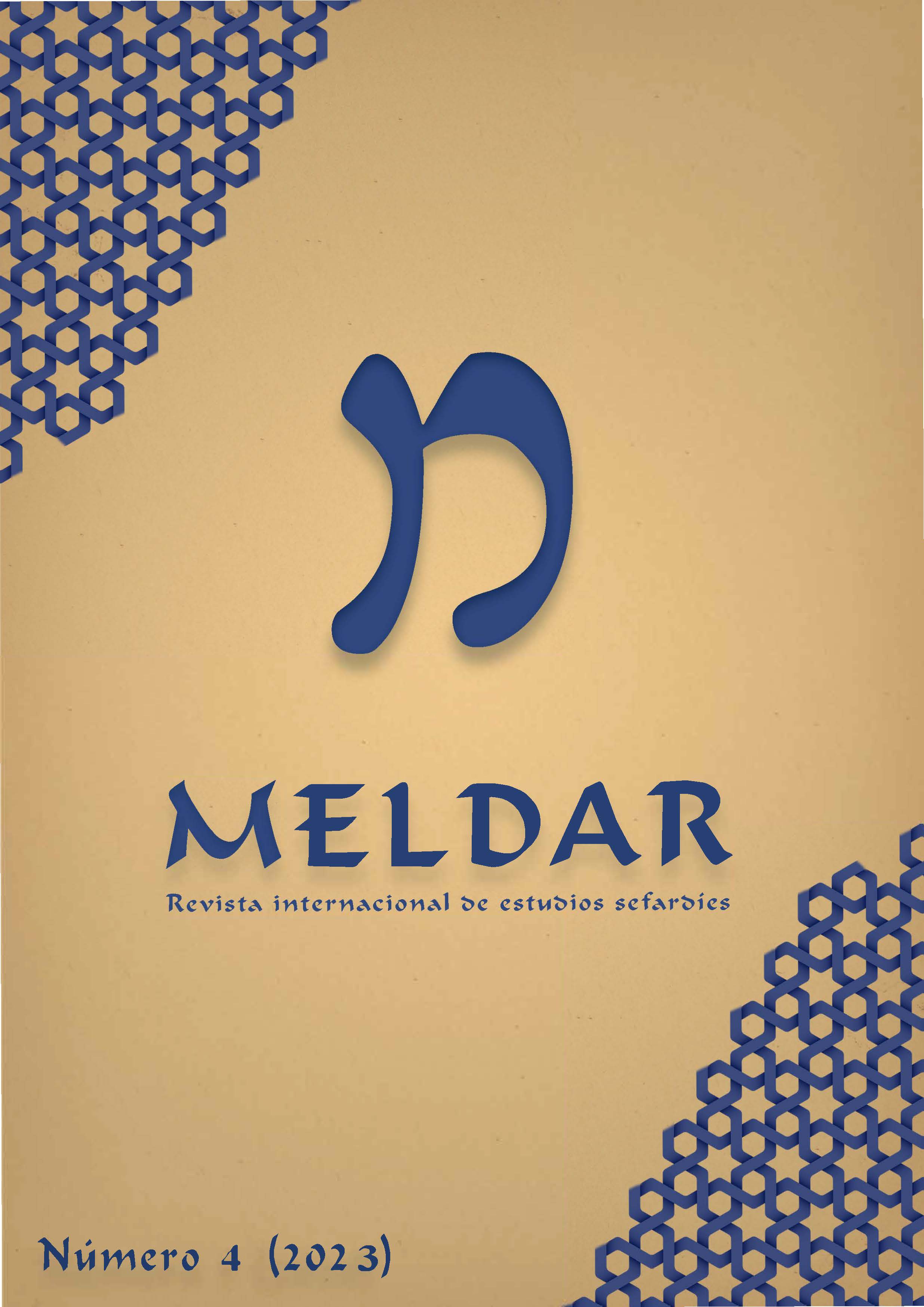The «Nation Ponentina» of Venice. Marks of the presence of the Sephardic community in the Ancient Jewish Cemetery of the Lido
DOI:
https://doi.org/10.46661/meldar.8461Keywords:
Venice, Jewish epigraphy, Jewish heraldry, Funerary poetryAbstract
The Sephardic community of Venice left its mark on the culture, literature, and traditions of the Jewish people of the Lagoon. This heritage can also be found in the Ancient Jewish Cemetery of the Lido. Sephardic tombstones are notable not only for their architectural style but also for the Sephardi script, the bilingual epitaphs, and the coats of arms engraved on the stone. The Sephardim were a valuable resource in the Venetian economy and commerce. They also founded a charity fraternity, whose statute was published in 1712 in both Portuguese and Italian. The study of tombstones and historical sources helps us to reconstruct the lives and events of the community members as well as understand important aspects of the literary, artistic, and linguistic culture of the Sephardic Jews in the diaspora.
Downloads
References
Andreatta, Michela. (2007). Poesia religiosa ebraica di età barocca. L’innario della confraternita Šomerim La-boqer (Mantova 1612). Padua: Studio Editoriale Gordini.
Andreatta, Michela. (2008). L’epitaffio ebraico come genere letterario. En Anna Mortari, Claudia Bonora Previdi (eds.), Il ‘giardino’ degli ebrei. Cimiteri ebraici nel mantovano (pp. 9-29). Florencia: Giuntina.
Arnold, Rafael. (2006). Laboratorio culturale. Il ghetto veneziano e le sue tre nazioni. En Susanne Winter (ed.), Venezia, l’altro e l’altrove. Aspetti della percezione reciproca (pp. 99-126). Roma: Edizioni di storia e letteratura.
Arnold, Rafael. (2010). Plurilinguismo, Paronomasia e Interstizi: l’uso linguistico degli ebrei a Venezia nel Seicento. En Uwe Israel et al. (eds.), Interstizi: culture ebraico-cristiane a Venezia e nei suoi domini tra basso Medioevo e prima età moderna (pp. 497-516). Roma: Edizioni di storia e letteratura.
Braamcamp Freire, Anselmo. (1921-1930). Brasões da Sala de Sintra, 3 voll. Coimbra: Imprensa da Universidade.
Buonafalce, Ilaria. (2000). Araldica della borghesia ebraica in Livorno: origini, consuetudini e testimonianze monumentali. En L’identità genealogica e araldica. Fonti, metodologie, interdisciplinarità, prospettive. Atti del XXIII Congresso internazionale di scienze genealogica e araldica. Torino, Archivio di Stato, 21-26 settembre 1998. Roma: Pubblicazioni degli archivi di stato.
Cantera Burgos, Francisco y Millás Vallicrosa, José María. (1956). Las inscripciones hebraicas de España. Madrid: Instituto Arias Montano CSIC.
Di Leone Leoni, Aron. (1992). La nazione ebraica spagnola e portoghese negli stati Estensi. Rimini: Luisè.
Di Leone Leoni, Aron. (2011). La Nazione Ebraica Spagnola e Portoghese di Ferrara (1492-1559). Florencia: Olschki.
Friedenberg, Daniel M. (1987). Medieval Jewish Seals from Europe, Detroit: Wayne State University Press.
Friedenberg, Daniel M. (1992). A bonanza of Spanish Jewish pre-expulsion seals. Jewish Art, 18, 100 108.
Garel, Michel. (1999). Le livre hébraïque 3. L’héraldique dans les manuscrits hébreux. Conférences de la Bibliothèque nationale de France (Grabación de la conferencia del 21 de octubre 1999).
Graziani Secchieri, Laura (ed.). (2014). Ebrei a Ferrara ebrei di Ferrara. Aspetti culturali, economici e sociali della presenza ebraica a Ferrara. Florencia: Giuntina.
Ioly Zorattini, Pier Cesare. (1980-1999). Processi del S. Uffizio di Venezia contro ebrei e giudaizzanti. Voll. I-XIV. Florencia: Olschki.
Ioly Zorattini, Pier Cesare. (1986). I cimiteri sefarditi di Ferrara. Annali di Ca’ Foscari. Rivista della facoltà di lingue e letterature straniere dell’Università di Venezia, serie orientale 17, 25(3), 33-60.
Ioly Zorattini, Pier Cesare. (1992). Ebrei sefarditi, marrani e nuovi cristiani a Venezia nel Cinquecento. En Guido Nathan Zazzu (ed.), E andammo dove il vento ci spinse. La cacciata degli ebrei dalla Spagna (pp. 115-137). Genova: Marietti.
Kaplan, Yosef. (2011). Between Christianity and Judaism in Early Modern Europe: The Confessionalization Process of the Western Sephardi Diaspora. En Lothar Gall y Dietmar Willoweit (eds.), Judaism, Christianity and Islam in the Course of History: Exchange and Conflicts (pp. 307-341). Múnich: R. Oldenbourg Verlag. https://doi.org/10.1515/9783110446739-025
Kaplan, Yosef (ed.). (2019). Religious Changes and Cultural Transformations in the Early Modern Western Sephardic Communities. Leiden/Boston: Brill. https://doi.org/10.1163/9789004392489
Leite de Vasconcelos, José. (1918). Signum Salomonis. O Arqueólogo Português, XXIII, 203-316.
Livro do Armeiro-Mor, Arquivo Nacional da Torre do Tombo (Lisboa), Casa Real, Cartório da Nobreza, liv. 19. Recuperado de https://digitarq.arquivos.pt/details?id=4162406
Luzzatti, Michele. (1980). Antichi cimiteri ebraici in Pisa. En Bruno di Porto (ed.), Gli ebrei in Toscana dal Medioevo al Risorgimento. Fatti e momenti (pp. 11-20). Florencia: Olschki.
Luzzatto, Aldo. (2000). La comunità ebraica di Venezia e il suo antico cimitero. Milán: Il Polifilo.
Maifreda, Germano. (2021). Italya. Storie di ebrei, storia italiana. Milán: Laterza.
Malkiel, David. (2013). Stones Speak. Hebrew Tombstones from Padua, 1529-1862. Leiden/Boston: Brill. https://doi.org/10.1163/9789004265349
Menéndez Pidal, Faustino y Gómez Pérez, Elena. (1987). Matrices de sellos españoles (siglos XII al XVI), Madrid: Ministerio de Cultura. Direccion gral. de Bellas Artes y Archivos.
Minervini, Laura. (2006). Experiencias culturales de los sefardíes en Italia en el siglo XVI. En Paloma Díaz-Mas y Harm den Boer (eds.), Fronteras e interculturalidad entre los sefardíes occidentales. Foro Hispánico, Vol. 28 (pp. 21-33). Leiden/Boston: Brill. https://doi.org/10.1163/9789401202503_004
Perani, Mauro. (2016). Italia “paniere” dei manoscritti ebraici e la loro diaspora nel contesto del collezionismo in Europa tra otto e novecento. La Rassegna Mensile di Israel, 82(2-3), 63-92.
Ravid, Benjamin. (1973). The establishment of the “Ghetto Vecchio” of Venice, 1541. Proceedings of the World Congress of Jewish Studies, Volume II, 153-167.
Ravid, Benjamin. (1991). A Tale of Three Cities and Their Raison d’état: Ancona, Venice, Livorno and the Competition for Jewish Merchants in the Sixteenth Century. Mediterranean Historical Review, 6 (2), 138-162. https://doi.org/10.1080/09518969108569619
Ravid, Benjamin. (1993). Los Sefarditas en Venecia. En Henry Méchoulan (ed.), Los judíos de España: Historia de una diáspora 1492-1992 (pp. 279-290). Madrid: Editorial Trotta.
Ravid, Benjamin. (2018). The Sephardic Jewish Merchants of Venice, Port Jews, and the Road to Modernity. En Federica Francesconi,
Stanley Mirvis y Brian Smollett (eds.), From Catalonia to the Caribbean: The Sephardic Orbit from Medieval to Modern Times. Essays in Honor of Jane S. Gerber. Brill's Series in Jewish Studies, 61, (pp. 115-135). Leiden/Boston: Brill. https://doi.org/10.1163/9789004376717_009
Registros de los muertos de la Comunidad judía de Venecia (Archivio Renato Maestro). Registros 1601-1617; 1617-1627; 1627-1653.
Regulaçao e ordens pella quais se haverà de Governar a חברת עזרת אחים Istituida no anno 5472 no K. K. De Talmud Torah. (1712). Venecia: Giovanni de’ Paoli.
Roth, Cecil. (1933). Gli Ebrei in Venezia. Bolonia: Forni Editore.
Roth, Cecil. (1928-1931). The Jews of Malta. Transactions (Jewish Historical Society of England), 12, 187 251.
Roth, Cecil. (1949). Lettere della Compagnia del riscatto degli schiavi in Venezia. La Rassegna Mensile di Israel, 15 (1), 31-36.
Roth, Cecil. (1955). Were the Sephardim Hidalgos? History Disputes Their Claim to Aristocracy. Commentary, New York.
Roth, Cecil. (2003). Storia dei Marrani. Genova: Marietti.
Ruiz-Taboada, Arturo. (2015). Comments on Muslim, Jewish and Christian Burial Practices in Medieval Toledo (Spain). Journal of Islamic Archaeology, 2(1), 51-71. https://doi.org/10.1558/jia.v2i1.26043
Ruspio, Federica. (2007). La nazione portoghese. Ebrei ponentini e nuovi cristiani a Venezia. Turín: Silvio Zamorani Editore.
Sárraga, Marian y Sárraga Ramón F. (2000). Early links between Amsterdam, Hamburg and Italy: Epitaphs from Hamburg’s Old Sephardic Cemetery. Studia Rosenthaliana, 34(1), 23-55.
Sárraga, Marian y Sárraga Ramón F. (2002). Sephardic Epitaphs in Hamburg’s Oldest Jewish Cemetery: Poetry, Riddles, and Eccentric Texts. AJS Review, 26(1), 53-92. https://doi.org/10.1017/S0364009402000028
Sárraga, Marian y Sárraga Ramón F. (2005). Hamburg’s Sephardic Hebrew Epitaphic Poems in Amsterdam Texts. Jewish Studies Quarterly, 12(4), 330-370. https://doi.org/10.1628/094457005783478324
Scazzocchio Sestieri, Lea. (1992). 1492, l’espulsione dalla Spagna e i paesi di rifugio. En Guido Nathan Zazzu (ed.), E andammo dove il vento ci spinse. La cacciata degli ebrei dalla Spagna (pp. 7-26). Genova: Marietti.
Schwab, Moïse. (1907). Rapport sur les inscriptions hébraïques de l’Espagne. París: Imprimerie Nationale.
Soprintendenza per i beni artistici e storici di Venezia (ed.). (1999). Venezia Ebraica. Il restauro dell’antico Cimitero del Lido. Milán: Electa.
Spagnuolo, Antonio Giulio. (2021). Le pietre dell’eternità. I cimiteri ebraici di Ferrara alla luce dei registri comunitari e negli epitaffi delle stele funerarie [Tesis de doctorado]. Universidad de Bolonia.
Toaff, Ariel. (1992). Ebrei spagnoli e marrani nell'Italia ebraica del cinquecento. Una presenza contestata. La Rassegna Mensile di Israel , 58(1/2), 47-59.
Vivian, Angelo. (1980). Iscrizioni e manoscritti ebraici di Pisa, I. Egitto e Vicino Oriente, 3, 191-240.
Vivian, Angelo. (1981). Iscrizioni e manoscritti ebraici di Pisa, II. Egitto e Vicino Oriente, 4, 269-309.
Wilke, Carsten L. (2008). Dialogues of the Dead: Talking Epitaphs by Sephardi and Ashkenazi Rabbis of Hamburg. Zutot: Perspectives on Jewish Culture 5/1, 61-74. https://doi.org/10.1163/187502108785807030
Yardeni, Ada. (2002). The Book of Hebrew Script. History, Palaeography, Script Styles, Calligraphy and Design. Londres: The British Library.
Downloads
Published
How to Cite
Issue
Section
License
Copyright (c) 2023 Meldar: International Journal of Sephardic Studies

This work is licensed under a Creative Commons Attribution-NonCommercial 4.0 International License.
Your manuscript will be published under under a Creative Commons Licence 4.0 (CC BY-NC): Attributed-NonCommercial, as follows:
- The authorship and original source of its publication (magazine, editorial and URL of the work) are cited.
- Not used for commercial purposes.
- The existence and specifications of this use license are mentioned.




 @meldar__
@meldar__


